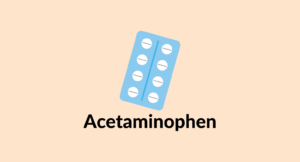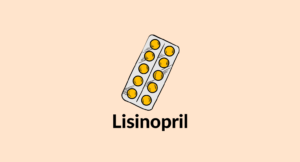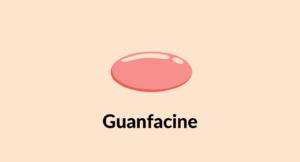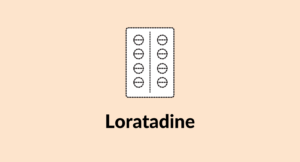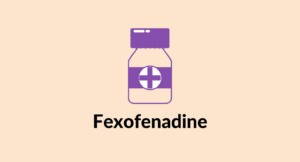Does CBD Interact with Aspirin (Acetylsalicylic Acid)?
Information on risks & possible interactions between CBD & aspirin.
Cannabidiol or CBD is a non-psychoactive cannabinoid derived from the Cannabis sativa plant commonly used to manage chronic pain and inflammation.
Aspirin (acetylsalicylic acid) is another common painkiller bought over the counter at drugstores and supermarkets.
Despite similar effects, the level of risk for interaction between these two substances is minimal.

Does CBD Interact With Aspirin?
CBD is unlikely to interact with low-dose Aspirin.
However, with higher doses or long-term use, CBD could, theoretically, increase serum levels of Aspirin over time — leading to potential side effects.
Both CBD and Aspirin are considered blood thinners and analgesics. It’s possible that this combination could lead to an increase in side effects associated with those effects — including the formation of bruises, blood loss, or liver damage.
However, in practice, none of these side effects have been reported and people who use both supplements on a daily basis rarely, if ever, experience any notable side effects.
Other Names for Aspirin
Aspirin is the generic name for acetylsalicylic acid (ASA). It’s sold under many different names. All share the same risk and potential interactions.
Other names for Aspirin include:
- Aspirin
- Ascriptin
- Aspergum
- Aspirtab
- Bayer
- Easprin
- Ecotrin
- Ecpirin
- Entercote
- Genacote
- Halfprin
- Ninoprin
- Norwich Aspirin
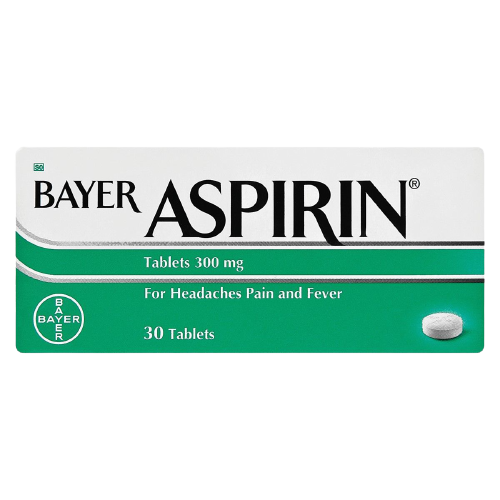
Similar Medications: CBD & NSAIDs
Acetaminophen is classified as an NSAID (non-steroidal anti-inflammatory drug). CBD and NSAIDs all share similar risks for interaction and side effects.
Here’s a list of similar medications that share a similar level of risk when combined with CBD:
- Ibuprofen (Motrin, Advil, Nuprin, Caldolor & Neoprofen)
- Celecoxib (Celebrex & Onsenal)
- Naproxen (Aleve)
- Ketorolac (Toradol)
- Etodolac (Ultradol)
- Meloxicam (Mobic)
Is It Safe to Take CBD & Aspirin Together?
It’s safe to take CBD along with low-dose Aspirin in most cases. If you’ve been prescribed high potency Aspirin, or are taking Aspirin on a daily basis to manage the risk of heart disease, it’s a good idea to speak with your doctor before starting CBD.
While it’s unlikely CBD is going to interact with Aspirin directly, it may be contraindicated for certain types of heart disease.
Is CBD a Viable Alternative to Aspirin?
CBD is widely used for several benefits, the main ones being pain relief and management of anxiety.
For mild to moderate pain and inflammation, CBD may be a viable, and potentially even more effective option than Aspirin.
For use as a blood thinner, CBD is not comparable to Aspirin and is not considered a viable alternative.
What is Aspirin?
Aspirin, and its generic component acetylsalicylic acid (ASA). It’s a medication commonly used for the treatment of pain, inflammation, and fever. It’s classified as a non-steroidal anti-inflammatory drug — NSAIDs for short.
It’s widely prescribed to patients with cardiac disorders such as heart attack, heart failure, or cardiac arrests as a blood thinner that will prevent any blood clots from forming, and consequently, producing a cardiac injury.
Aspirin is readily available in pharmacies and does not need a doctor’s prescription before it can be purchased from these pharmacies. The drug is manufactured by different pharmaceutical companies and, hence, is available under different trade names, such as Bayer, Easprin, Ecotrin, and Ecoprin, to name a few.
Aspirin has a half-life of either 2 hours to 3 hours, or 15 hours to 30 hours, depending on the dose, with the former being the half-life of 100 mg or less of Aspirin. The drug is excreted mostly through the urine, almost 80 percent, and the rest is excreted via feces and sweat.
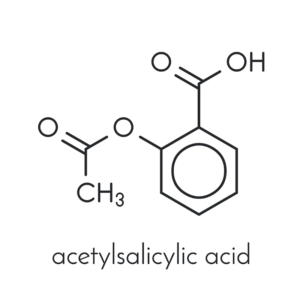
Aspirin Specs:
| Drug Name | Aspirin (Acetylsalicylic acid) |
| Trade Name | Aspirin, Aspro Clear, Bayer, Disprin, Easprin, Ecotrin, Ecoprin, Entercote |
| Classification | Non-Steroidal Anti-inflammatory Drug (NSAID) |
| CYP Metabolism | Liver (CYP2C19 and CYP3A) |
| Interaction with CBD | Agonistic (Increased effects) |
| Risk of Interaction | Low |
What Does Aspirin Do?
Aspirin is used to treat a number of medical conditions that present with symptoms such as fever, pain, and inflammation. It’s one of the most commonly prescribed medications in cardiology clinics as its blood-thinning abilities are crucial for patients who have recently suffered from a heart attack or a stroke.
The mechanism of action of Aspirin includes irreversible inhibition of the enzyme, Cyclooxygenase or COX, which is crucial for the synthesis and distribution of prostaglandins and thromboxane in the body.
There are two different types of cyclooxygenases in the human body, namely COX1 and COX2 enzymes with the former being responsible for the production of thromboxanes, a hormone responsible for vasoconstriction and platelet aggregation in the blood vessels.
COX1 is irreversibly inhibited by Aspirin, whereas COX2, the enzyme responsible for the production of the hormone prostaglandins which induces the release of pro-inflammatory cytokines, activity is modified by the drug.
COX2 activity modification results in the conversion of the enzyme’s ability to produce prostaglandins to producing a lipoxygenase enzyme which helps with the metabolism of different polyunsaturated fats in the human body.
The inhibitory effect of Aspirin on the COX1 enzyme helps the medication manage bleeding as irreversible inhibition of thromboxane A2 in platelets inhibits platelet aggregation for 7 days to 8 days, the life span of the affected platelet. This mechanism is responsible for the prescription of Aspirin to patients with a history of heart attack, strokes, transient ischemic attack, and unstable angina, to help prevent recurrence of these medical emergencies.
Prostaglandins play a huge role in the information transmission from the brain to the different parts of the body suffering from pain and inflammation. They are also known to have an effect on the regulation of the hypothalamus’ thermal center, hence altering body temperature and interrupting the body’s temperature homeostasis.
Inhibition of these prostaglandins by inhibiting the enzyme required for their synthesis is essential for the management of pain and inflammation in the body. Aspirin can manage and treat fever-like symptoms by inhibiting these hormones and inducing proper regulation of body temperature.
Irreversible inhibition of local hormones in the body, and eventually platelet aggregation is what separates Aspirin from other NSAIDs such as Ibuprofen and Diclofenac as they are reversible inhibitors.
Adverse Effects of Aspirin
Aspirin is a widely available, over-the-counter medication that is used by almost all age groups. However, it’s crucial to keep in mind the fact that there are several side effects of this medication that need to be considered.
Aspirin use is contraindicated in pregnancy, especially after the 20th week of pregnancy as it can result in kidney disorders in the fetus as a result of decreased levels of amniotic fluid.
Moreover, it isn’t recommended to be used in children with influenza or the common cold, as it can result in the development of a nearly fatal, progressive brain disease known as Reye’s Syndrome. The use of this medication is contraindicated to patients on warfarin treatment or those with disorders affecting the lining of the stomach such as peptic ulcers and gastritis. The medication should not be taken with alcohol.
Some of the common side effects of Aspirin include:
- Skin rash
- Gastrointestinal ulcers
- Abdominal pain
- Abdominal cramping
- Abdominal distress
- Heartburn
- Tinnitus
- Drowsiness
- Headache
Aspirin should not be used if there is a history of gastrointestinal disorders, without the recommendation of a healthcare professional.
Some of the more severe side effects of Aspirin include:
- Retinal vein occlusion
- Cerebral microbleeds
- Reye Syndrome
- Gastrointestinal bleeding
Types of Drug Interaction With CBD
Cannabidiol or CBD has several benefits that can be credited for its rising popularity, however, it can produce severe complications when it interacts with other drugs.
CBD can interact with other drugs to produce either increased or decreased effects of the main drug.
These interactions can have either low, moderate, or severe clinical significance with low interactions not requiring any form of precaution, moderate interactions being avoided unless medically necessary, and severe being avoided at all costs.
Based on the effect of CBD on the main drug, the CBD-drug interactions can be classified into three types:
1. Agonistic Interaction
CBD increases the effect of the drug by exerting the same effects. This is common in drugs that share similar painkilling, sedative, anxiolytic, or anti-inflammatory effects.
2. Antagonistic Interaction
CBD decreases the effect of the drug by either clearing the drug from the system faster or inhibiting its effects. This is common in drugs with effects that are opposite to CBD — such as stimulants, emetics, or low blood pressure medications.
3. Metabolic Competition
CBD blocks or competes with the metabolism of medications in the liver. This can cause the concentrations of both substances to increase in the bloodstream, potentially leading to side effects.
This interaction is most concerning for medications used on a daily basis because it can cause levels to rise to dangerous levels over time.

Key Takeaways: Can CBD and Aspirin be Taken Together?
CBD and Aspirin have similar effects for managing pain and inflammation. There’s some mild risk of interaction between these substances, but only when used in high doses or for long periods of time.
Most people find greater pain relief when using both Aspirin and CBD together.
References
- Atalay, S., Jarocka-Karpowicz, I., & Skrzydlewska, E. (2020). Antioxidative and anti-inflammatory properties of cannabidiol. Antioxidants, 9(1), 21.
- Pellati, F., Borgonetti, V., Brighenti, V., Biagi, M., Benvenuti, S., & Corsi, L. (2018). Cannabis sativa L. and nonpsychoactive cannabinoids: their chemistry and role against oxidative stress, inflammation, and cancer. BioMed research international, 2018.
- Sofia, R. D., Vassar, H. B., & Knobloch, L. C. (1975). Comparative analgesic activity of various naturally occurring cannabinoids in mice and rats. Psychopharmacologia, 40(4), 285-295.
Signup to our newsletter
Be the first to know about our newest arrivals and special offers!
